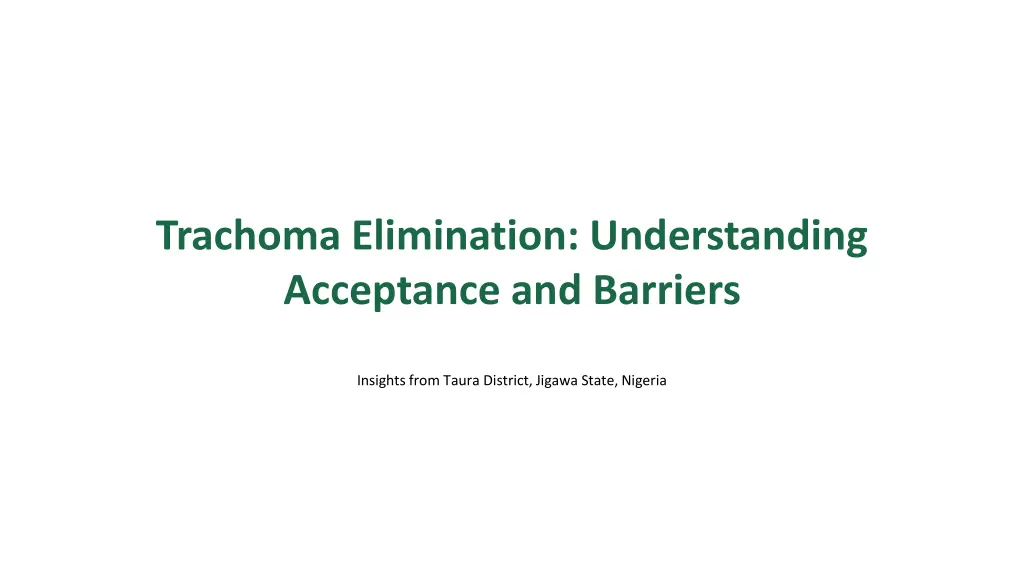
Insights into Trachoma Elimination Challenges and Acceptance Factors in Taura District, Nigeria
Explore the factors influencing acceptance of antibiotics during mass drug administration (MDA) for trachoma elimination in Taura District, Jigawa State, Nigeria. Discover key findings, barriers, and recommendations for improving MDA coverage to eliminate trachoma effectively and enhance community health.
Download Presentation

Please find below an Image/Link to download the presentation.
The content on the website is provided AS IS for your information and personal use only. It may not be sold, licensed, or shared on other websites without obtaining consent from the author. If you encounter any issues during the download, it is possible that the publisher has removed the file from their server.
You are allowed to download the files provided on this website for personal or commercial use, subject to the condition that they are used lawfully. All files are the property of their respective owners.
The content on the website is provided AS IS for your information and personal use only. It may not be sold, licensed, or shared on other websites without obtaining consent from the author.
E N D
Presentation Transcript
Trachoma Elimination: Understanding Acceptance and Barriers Insights from Taura District, Jigawa State, Nigeria
01 Introduction to Trachoma Table of Contents 02 Study Objectives 03 Methodology Overview 04 Key Findings: Acceptance Predictors 05 Reasons for Non-Acceptance 06 Identified Barriers to Acceptance 07 Provider-Related Barriers 08 Recommendations for Improvement 09 Conclusion: A Path Forward 10 Thank You!
1 Introduction to Trachoma Trachoma is a debilitating eye disease caused by Chlamydia trachomatis. It leads to blindness if untreated and is prevalentin many developing regions. Taura District in Jigawa State, Nigeria, is one of the trachoma-endemic zones, facing challenges with low coverage of mass drug administration (MDA). The need for effective MDA is urgent to eliminate the disease and improve community health and quality of life. This study aimed to explore the predictors of acceptance and identify barriers to MDA uptake to inform better health interventions.
2 Study Objectives The primary objective was to identify what influences people's acceptance of antibiotics during MDA in Taura District. We also aimed to uncover barriers that prevent individuals from participating in the antibiotic distribution programs. Understanding these factors is essential for improving MDA coverage and ultimately eliminating trachoma in the region.
3 Methodology Overview A mixed-method cross-sectional survey was conducted with a sample of 1,502 individuals from 202 households. Quantitative data was gathered through a structured questionnaire focusing on attitudes, beliefs, and practices regardingMDA. Qualitative insights were gained through four key informant interviews and three focus group discussions to explore acceptance barriers. The data was analyzed using STATA version 14.0 for quantitative results and thematic frameworks for qualitative data.
4 Key Findings: Acceptance Predictors Age plays a crucial role; older individuals are more likely to accept MDA (AOR=1.84). Higher educational qualifications significantlyincrease the likelihood of acceptance (AOR=2.64). Participants who recognize their risk of trachoma and understand additional benefits of antibiotics show higher acceptance rates. Household participation in previous MDAs significantly influences current acceptance levels as well.
5 Reasons for Non-Acceptance Despite the benefits, many individuals cited previous personal experiences of side effects as a major deterrent(32%). Fear of side effects also played a significant role in non-acceptance, affecting 23% of the respondents. Some participants believed they were not suffering from any illness, contributing to a 16% refusal rate. These perceptionsindicate a critical area for education and awareness campaigns.
6 Identified Barriers to Acceptance Low felt need for treatment among community members is a significant barrier to MDA participation. Rumors and misinformation about the treatmentcontribute to widespread fear and reluctance. Timing of the distribution process also poses challenges, making it unsuitable for many community members. Community Drug Distributors (CDDs) face motivational hurdles, affecting their effectiveness in outreach and distribution efforts.
7 Provider-Related Barriers Provider-relatedbarriers significantly impact MDA effectiveness; poor motivation of CDDs limits outreach. Additionally, a lack of adequate training and resources for CDDs undermines their role in community health initiatives. Addressing provider-related issues could enhance the overall success of MDA programs.
8 Recommendations for Improvement Increase awareness and education regarding the benefits of MDA and addressing misconceptions about side effects. Enhance community engagement throughparticipatoryhealth interventions to foster a sense of ownership. Optimize the timing of MDA distribution, making it more convenient for community members to participate. Empower CDDs throughbetter training and supportto motivate them in their roles as health advocates.
9 Conclusion: A Path Forward Understanding the predictors of acceptance and barriers to MDA is crucial for effective public health interventions. By addressing concerns and enhancing community engagement, we can improve acceptance of antibiotics for trachoma. Collaboration with local health authorities and communities is essential for the success of elimination efforts. Together, we can work towards a trachoma-free future in Taura District and beyond.
10 Thank You! Thank you for your attention and interest in this critical public health issue. Your engagement is vital in driving forward the success of mass drug administrationprograms. Together, let's strive to eliminate trachoma and improve community health. For further inquiries, feel free to reach out to the presenting author, Dr. Abdullahi Idris. Contact: dr.kiyawa@gmail.com | Phone: +2348060573098.
